Competitor keyword analysis involves examining the keywords that competitors target and rank for.
By understanding these insights, you can uncover valuable opportunities to optimize your content and climb the search engine rankings.
In this guide, you'll discover how to leverage competitor analysis to identify high-impact keywords and create content that effectively competes in your industry.
Let’s explore how to turn your competitors' strategies into your own success stories.
Here's what we'll cover:
Plus, get a free SEO analysis report for your competitor's domain!
What Is Competitor Keyword Analysis?
Competitor keyword analysis is a process of understanding who your online competitors are and identifying what specific keywords or topics drive their success.
Naturally, your goal is to uncover phrases that help your competitors achieve organic growth that you haven’t identified yet. This allows you to uncover new opportunities fast and learn from someone else’s experience.
A correctly conducted competitor analysis will also help you answer some of the most burning questions you may have about your competitors:
- What keywords drive their success that you don't rank for?
- What topics should you focus on in your content? This insight alone can greatly improve the success of your content marketing and SEO strategy.
- What else you can do to beat the competition? It will help you broaden your horizons and reveal strategies you may not have considered yet.
Uncover your competition's top keywords and ranking pages with an at-a-glance SEO report.
Why Is Competitor Keyword Analysis Important for SEO?
Many SEOs struggle with understanding the vast landscape of their industry, which often includes thousands of keywords and topics.
By diving into your competitors' keywords, you can streamline this process and uncover innovative strategies they use to dominate search results.
Reverse engineering their success not only reveals their secrets but also inspires new ideas and helps you prioritize your SEO efforts based on what truly works.
How to Conduct Competitor Keyword Analysis
Running an SEO competitor keyword analysis consists of four primary steps:
-
Identify your real online competitors
-
Find those competitors' keywords
-
Identify the Keyword Gaps
-
Prioritize Which Keywords to Target
Step #1. Identify Your Real Online Competitors
You likely already know your market competitors—companies offering similar products or services to the same audience, including direct, manufacturer, and offline competitors.
However, your direct online competitors might differ according to Google.
Many organizations, including those providing complementary products or even non-commercial sites like Wikipedia, can compete for your target keywords.
Take a look at this breakdown of online competitors for a particular set of keywords. If you were an enterprise-level store, I’m sure you wouldn’t count Google Image, Etsy, or even Polyvore as your competitors.
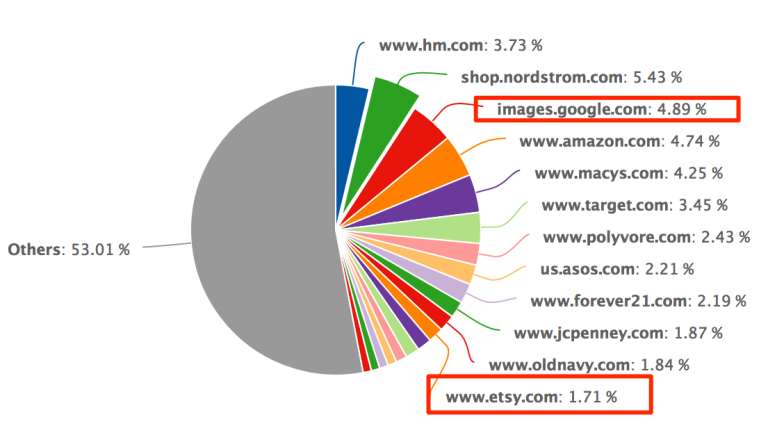
But even though you wouldn't normally battle for the market share from them directly, the important thing to understand about online competitors is that these domains receive traffic that could be yours.
So, the first step in any competitive keyword analysis is identifying these key online competitors.
We can do this in just a few clicks with seoClarity’s Research Grid by simply entering your target keyword to see the top-ranking URLs. They may surprise you!
Go ahead and try it out yourself with a .
.
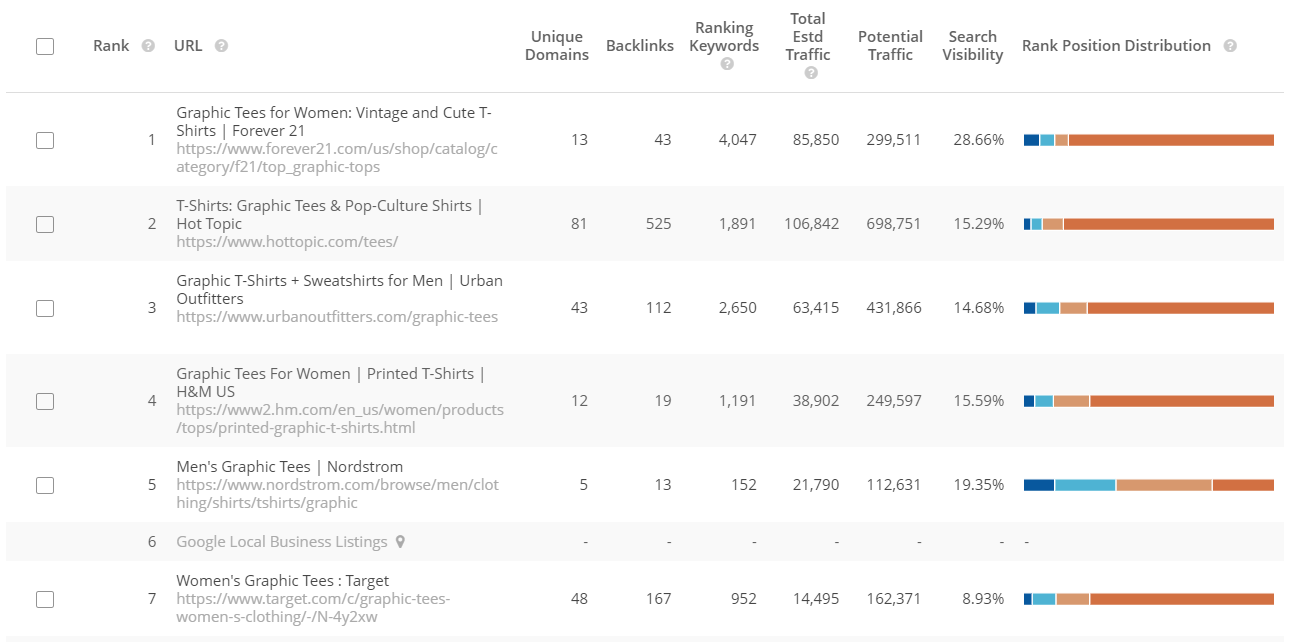 (Uncovering the competition in seoClarity’s Research Grid.)
(Uncovering the competition in seoClarity’s Research Grid.)
You can also uncover your top competitors for a specific topic as opposed to an individual keyword by entering your topic into Topic Explorer which includes a data set of more than 28 billion keywords.
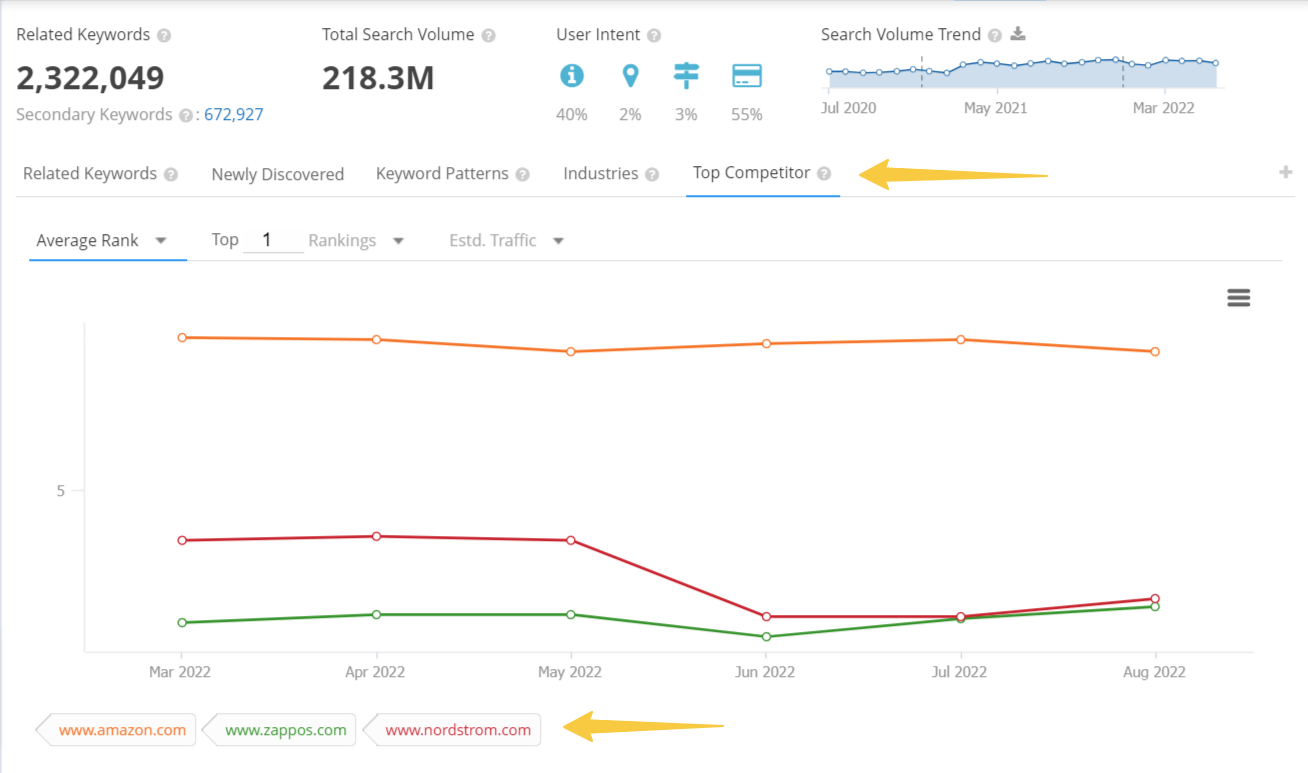 (Top Competitors view in Topic Explorer for the topic "shoes".)
(Top Competitors view in Topic Explorer for the topic "shoes".)
For example, with the topic "shoes," you can see who is ranking for over two million related keywords, how they've historically performed, and how you perform in comparison
The 6-month trended view reveals whether a competitor is gaining or losing strength, helping you pinpoint who to monitor as we move to the next step: finding your competitors' keywords.
Step #2. Find Competitor Keywords
Now you're probably wondering, "How do I find my competitors' ranking keywords?"
Once you know who your ranking competitors are, start by analyzing those domains.
Return to Research Grid and enter a URL or domain instead of a specific keyword. It will report on various metrics regarding the domain’s performance, including a list of keywords for which it ranks.
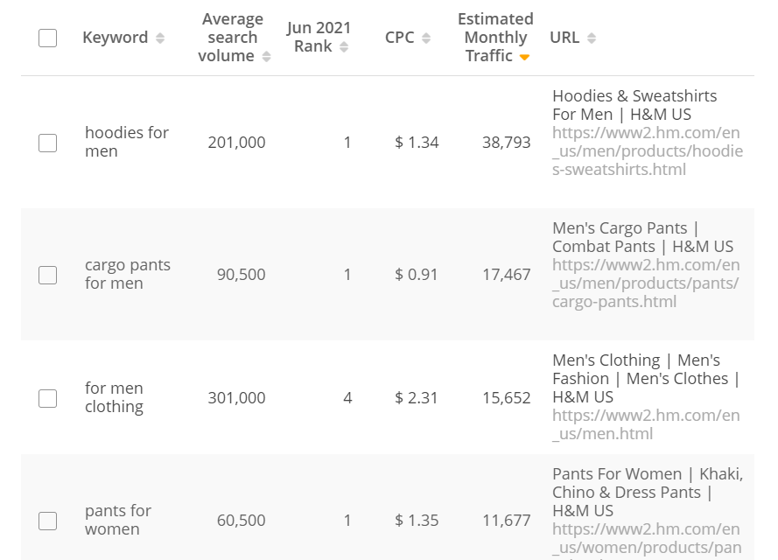
(Uncovering a domain's ranking keywords and their respective URLs.)
You can also use filters like rank, estimated traffic, industry, and SERP features to fine-tune the search. This capability allows you to discover the phrases driving traffic to your competitors.
Step #3. Identify the Keyword Gaps
Next, evaluate which of those keywords you don't rank for yet. This approach is called closing the content gap. And it’s as simple as entering the domain of your choice and seeing how top competitors rank comparatively.
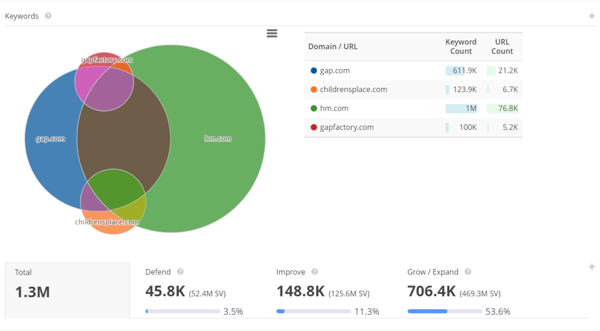
(Content Gaps - that is, opportunity! - between two domains.)
The analysis tells you which keywords to defend, improve, and grow.
Keywords in the "defend" category are terms that you either rank in the top five positions for or rank better than your competitors. "Improve" keywords are terms where you rank below the top five or below competitors.
And keywords in the "grow" category are keywords where your competitors rank but you don't. These represent your keyword gaps. By addressing them, you can enhance your content's visibility and attract more potential customers.
Step #4. Prioritize Which Keywords to Target
Now that you've identified your keyword gaps, it's time to analyze them to determine which ones will provide the most impactful opportunities.
When prioritizing which keywords to focus on, we suggest considering:
- Relevance: Ensure the keywords are closely related to your products and services.
- User Intent: Target phrases with transactional intent first to prioritize users further along in the buying cycle, increasing the likelihood of converting visits into sales or leads.
- Search Volume: Higher search volume often means more potential traffic.
- Keyword Difficulty: Evaluate how competitive it is to rank for the keyword.
- Number of Ranking Competitors: If multiple competitors rank for a keyword, you might want to prioritize it over keywords with only one ranking competitor.
To simplify the keyword analysis process, seoClarity allows you to filter keywords by each of these metrics, making it easier to pinpoint the most impactful keywords to target.

Recommended Reading: Content Gap Analysis: How to Identify and Close Your Content Gaps
Tools to Use for a Competitor Keyword Analysis
Any tool capable of evaluating a competitor's keyword set can be useful, but the quality of insights will depend on the tool's data scope and depth.
For small websites, basic tools may suffice initially. However, for evaluating large keyword sets at scale, an enterprise SEO platform is essential.
An effective enterprise SEO platform should:
- Handle large datasets efficiently
- Deliver comprehensive data on competitors’ keywords
- Provide AI-driven insights to enhance your strategies
These capabilities ensure you gather the detailed information needed to optimize your content and outperform your competitors.
Next Steps
Identifying the competition and the keywords used for their organic campaigns is just the beginning.
After conducting competitor keyword analysis, you'll need to take steps to outrank your competition for the keywords you've identified.
To do so, examine your competitors' top-ranking pages for insights on content structure, length, and keyword usage. Using this information, update your current content or develop new content tailored to the keyword gaps you discovered, focusing on addressing user intent and providing valuable information.
Then, enhance your on-page SEO elements such as meta titles, descriptions, headers, and internal linking to better align with the target keywords.
Another strategy is to conduct link gap analysis to identify opportunities to build backlinks from high-authority sites that link to your competitors, enhancing your site's authority and improving search rankings.
Once you've taken these measures, regularly track your keyword rankings and organic traffic to assess the impact of your optimization efforts. Continuously refine your keyword strategy based on performance data and ongoing competitor analysis, ensuring you stay ahead in the search rankings.
Conclusion
Competitor keyword analysis empowers SEOs to identify and refine strategies that are already working for their competitors, bypassing the need for a lengthy trial-and-error process.
By leveraging the insights shared in this post, you now have a solid starting point for conducting competitive analysis in your digital marketing efforts.
Begin implementing these strategies today to enhance your SEO performance and stay ahead in the competitive landscape.
Learn how seoClarity can streamline and enhance your competitor keyword analysis process by scheduling a demo today!
Editor's Note: This post was originally published in May 2017 and has been updated with the latest and most accurate information to help you successfully discover your competitors' keywords.









3 Comments
Click here to read/write comments